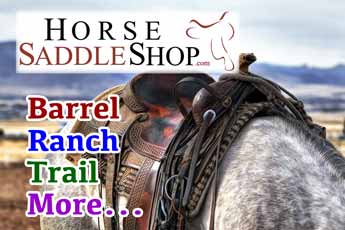Cowboy Dictionary - Letter U-Z
Ungulate - A mammal with hooves. Horses are odd-toed ungulates and cattle are even-toed ungulates.
Below: A horse hoof. A horse has one solid (not split) hoof at the bottom of each leg. Since one is an odd number, a horse is an odd-toed ungulate.
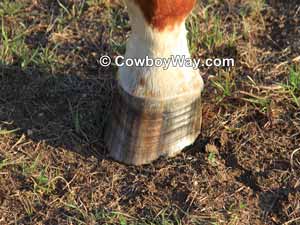
Below: Calf hooves. Cattle have a hoof that is split into two toes at the bottom of each leg. Since two is an even number, cattle are even-toed ungulates.
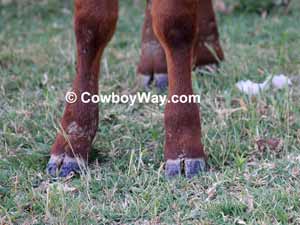
Water Loops - "Water loops" are used to attach reins to a bit. They are typically made of leather and are commonly used with leather split reins.
Below: The blue arrows are pointing to water loops.
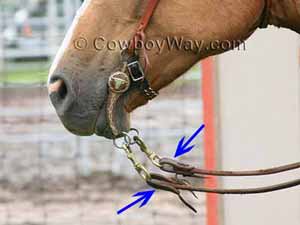
Water loops have several purposes: They are a convenient way to attach reins to a bit, they take some of the wear of daily use off the reins, and they can add a little bit of weight to help enhance the "feel" of communication between horse and rider.
Water loops also far less expensive than a pair of nice leather reins, so if a water loop breaks instead of a rein it's a less expensive repair.
In addition, if a rein should happen to break where it attaches to a water loop, a lot less rein will need to be trimmed off than if the rein had been doubled over on itself rather than using a water loop.
Wet Cow - A cow that is currently producing milk. A cow becomes wet because she has given birth to a calf. A cow that is not producing milk is a dry cow.
Below: In this photo you can see this cow's udder (or "bag") is enlarged with milk. She gave birth to the calf standing next to her about two months before the photo was taken.
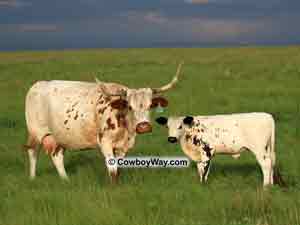
Advertisement - Article continues below.
Whole Head - In team roping and some other competitive roping events, a whole head is one of three legal head catches. A whole head is sometimes called "around the neck."
Below: A whole head catch.
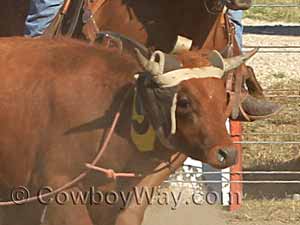
The other two legal head catches are a half head, and around the horns (sometimes called a "horn catch" or "a clean horn catch").
A whole head catch is pictured below. The loop goes behind the entire head, or around the neck. We have more information about the three legal head catches.
Wild Rag - A cowboy or Western scarf worn around the neck.
Wild rags are worn by working cowboys and cowgirls for warmth in cold temperatures, and for protection from sun, wind, and dirt anytime.
In many regions wild rags are a popular fashion accessory and are a standard part of cowboy dress whether it be for work or social occasions.
Wild rags come in a wide variety of colors, sizes, and fabrics. Silk is a popular fabric choice because of its light weight, softness, good looks, and other qualities.
Below: A wild rag.
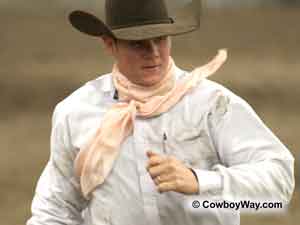
- You can see this page to learn how to take care of a silk wild rag.
- To learn how to tie a wild rag, you can see our article How To Tie A Wild Rag.
Windmill - In the United States a windmill is a wind-powered pump used to bring water out of the ground and pump it into stock tanks, irrigation ditches, or anywhere else it is needed.
In other areas of the world, however, a windmill is a type of wind-powered mill - not a water pump - that grinds whole grains.
Below: A windmill (the wind-powered pump kind) used to pump water into a stock tank for cattle.
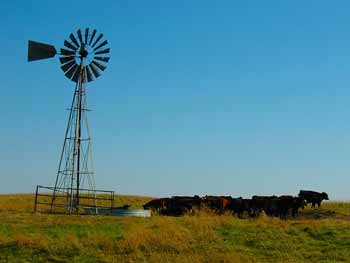
You can shop for windmill clocks here.
You can shop for windmill ceiling fans here.
Wooly Chaps - Wooly chaps, or "woolies," are chaps covered in fur.
Woolies are particularly popular in regions where the winters are long and cold, such as in the northern part of the United States.
Cowboys and cowgirls who wear woolies like them for their warmth and their ability to repel rain and snow.
Below: Wooly chaps on a ranch bronc rider.

Zony - A "zony" is a cross between a zebra and a pony.
Below: A zony.
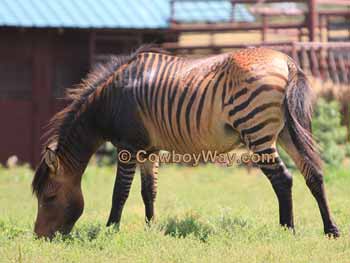
A broader, more inclusive word to use to describe a zony is "zebroid," which is the cross between a zebra and any other equine. For example, a cross between a zebra and a pony is a zony, and a cross between a zebra and a horse is a zorse. However, they are both zebroids.
Definitions
… Letter C
… Letter S
… Letter T
You Might Also Like
